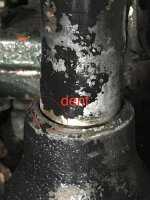AUSMHLY
Yoda
Offline
Here's a photo where I've circled where the dent is. See how the outer tube is not firmly attached, soldered, "sweated" to the steering box anymore. I can see a little oil there too. When turning the steering wheel, I can see the tube moves straight in and straight out, very little, but enough that I notice it. I don't think it's suppose to move, have any "free play" at all. The box is bolted firmly, the tube is bolted to the dash firmly. The tube has slight in/out movement where it enters the box. So, is this serious enough to remove the box and have this looked into?



 Hi Guest!
Hi Guest!

 smilie in place of the real @
smilie in place of the real @
 Pretty Please - add it to our Events forum(s) and add to the calendar! >>
Pretty Please - add it to our Events forum(s) and add to the calendar! >> 



